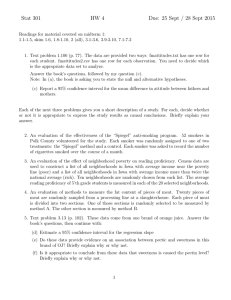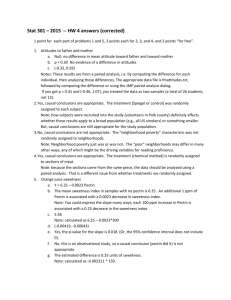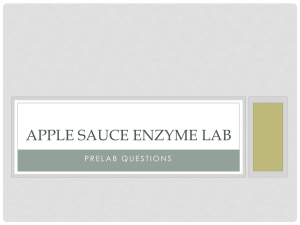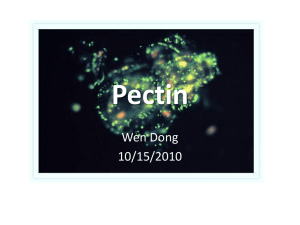Document 14104814
advertisement
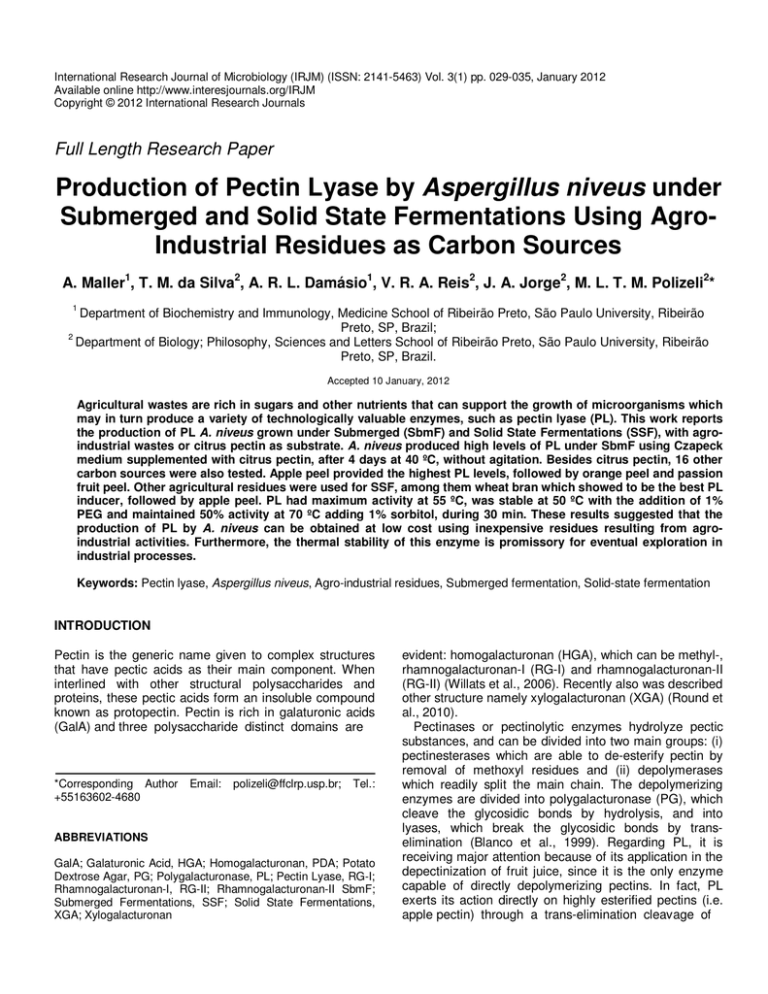
International Research Journal of Microbiology (IRJM) (ISSN: 2141-5463) Vol. 3(1) pp. 029-035, January 2012 Available online http://www.interesjournals.org/IRJM Copyright © 2012 International Research Journals Full Length Research Paper Production of Pectin Lyase by Aspergillus niveus under Submerged and Solid State Fermentations Using AgroIndustrial Residues as Carbon Sources A. Maller1, T. M. da Silva2, A. R. L. Damásio1, V. R. A. Reis2, J. A. Jorge2, M. L. T. M. Polizeli2* 1 Department of Biochemistry and Immunology, Medicine School of Ribeirão Preto, São Paulo University, Ribeirão Preto, SP, Brazil; 2 Department of Biology; Philosophy, Sciences and Letters School of Ribeirão Preto, São Paulo University, Ribeirão Preto, SP, Brazil. Accepted 10 January, 2012 Agricultural wastes are rich in sugars and other nutrients that can support the growth of microorganisms which may in turn produce a variety of technologically valuable enzymes, such as pectin lyase (PL). This work reports the production of PL A. niveus grown under Submerged (SbmF) and Solid State Fermentations (SSF), with agroindustrial wastes or citrus pectin as substrate. A. niveus produced high levels of PL under SbmF using Czapeck medium supplemented with citrus pectin, after 4 days at 40 ºC, without agitation. Besides citrus pectin, 16 other carbon sources were also tested. Apple peel provided the highest PL levels, followed by orange peel and passion fruit peel. Other agricultural residues were used for SSF, among them wheat bran which showed to be the best PL inducer, followed by apple peel. PL had maximum activity at 55 ºC, was stable at 50 ºC with the addition of 1% PEG and maintained 50% activity at 70 ºC adding 1% sorbitol, during 30 min. These results suggested that the production of PL by A. niveus can be obtained at low cost using inexpensive residues resulting from agroindustrial activities. Furthermore, the thermal stability of this enzyme is promissory for eventual exploration in industrial processes. Keywords: Pectin lyase, Aspergillus niveus, Agro-industrial residues, Submerged fermentation, Solid-state fermentation INTRODUCTION Pectin is the generic name given to complex structures that have pectic acids as their main component. When interlined with other structural polysaccharides and proteins, these pectic acids form an insoluble compound known as protopectin. Pectin is rich in galaturonic acids (GalA) and three polysaccharide distinct domains are *Corresponding Author +55163602-4680 Email: polizeli@ffclrp.usp.br; Tel.: ABBREVIATIONS GalA; Galaturonic Acid, HGA; Homogalacturonan, PDA; Potato Dextrose Agar, PG; Polygalacturonase, PL; Pectin Lyase, RG-I; Rhamnogalacturonan-I, RG-II; Rhamnogalacturonan-II SbmF; Submerged Fermentations, SSF; Solid State Fermentations, XGA; Xylogalacturonan evident: homogalacturonan (HGA), which can be methyl-, rhamnogalacturonan-I (RG-I) and rhamnogalacturonan-II (RG-II) (Willats et al., 2006). Recently also was described other structure namely xylogalacturonan (XGA) (Round et al., 2010). Pectinases or pectinolytic enzymes hydrolyze pectic substances, and can be divided into two main groups: (i) pectinesterases which are able to de-esterify pectin by removal of methoxyl residues and (ii) depolymerases which readily split the main chain. The depolymerizing enzymes are divided into polygalacturonase (PG), which cleave the glycosidic bonds by hydrolysis, and into lyases, which break the glycosidic bonds by transelimination (Blanco et al., 1999). Regarding PL, it is receiving major attention because of its application in the depectinization of fruit juice, since it is the only enzyme capable of directly depolymerizing pectins. In fact, PL exerts its action directly on highly esterified pectins (i.e. apple pectin) through a trans-elimination cleavage of 030 Int. Res. J. Microbiol. glycosidic bonds (Busto et al., 2006; Spagna et al., 1995). Pectic enzymes can be applied in food industry, as in fruit ripening, clarification and diminution of the viscosity in juices, grape treatment in wine manufacturing, tomato pulp extraction, tea fermentation, vegetable waste treatment, textile and paper manufacture, animal feed, and oil extraction (Uenojo and Pastore, 2007). PL decreases the juice viscosity without the need of a preliminary de-esterification, which usually precedes hydrolytic cleavage of pectin. Furthermore, it enables juice clarification without the destruction of volatile ester components, conferring specific fruit fragrance to the product and its use does not generate methanol during the manufacturing process (Sinitsyna et al., 2007). The inevitable population and economic growth generates an increasing alimentary demand and, consequently, production of residues. Thus, its environmental effect constitutes one of the problems of food security/safety. It is believed that half of the food produced is discarded before and after it reaches consumers and one third to half of waste comes from the food sector. Then, there is an increasing interest in recycling these residues in order to add value to the product and to diminish environmental contamination (Lin et al., 2009). Yearly, 45 million tons of vegetables, fruits, and grain products are lost to waste in the United States, with costs approximately $1 billion. Also, the United Kingdom produces 20 million tons of food waste annually (Kosseva, 2009). According to the data of Brazil’s Ministry of Agriculture and Food Supply, wheat production in 2005 was 4,659 thousand tons. The production of apple, orange, and passion fruit was 19,184 thousand tons, where the citric fruit production was greater, with 17,868 thousand tons (Lin et al., 2009). It is believed that up to 96% of orange production is consumed and 50% of this is formatted residue (Alexandrino et al., 2007), used mostly in animal feed. Agricultural wastes are rich in sugars which can be easily assimilated by microorganisms. This means that residues, like sugarcane bagasse, apple pomace, fruit peels and cereal straws, can be used as carbon sources in SSF to obtain industrially useful products, and can help reduce pollution problems (Couto, 2008; Soccol and Vandenberghe, 2003). Fungi have the ability to degrade lignocellulosic materials due to their efficient enzymatic systems (Sánchez, 2009). In this sense, Aspergillus niveus, showed great capacity to produce large amounts of hydrolytic enzymes, like xylanases (Peixoto-Nogueira et al., 2009) and amylases (Silva et al., 2009) when cultivated in media supplemented with agricultural wastes. The aim of this study was to define the conditions for PL production by A. niveus under SbmF and SSF using fruit peels and other agro-industrial residues as carbon sources. MATERIALS AND METHODS Organism and growth conditions in SbmF Aspergillus niveus Saito strain was isolated from Mangifera indica in our laboratory. The microorganism was identified and deposited in the culture collection of Pernambuco Federal University (PE, Brazil). The organism was maintained on slants of Potato Dextrose Agar (PDA) medium at 30 ºC. A quantity of 5 x 106 conidia from these cultures was inoculated into 125-mL Erlenmeyer flasks containing 25 mL of liquid Czapeck medium (Wiseman, 1975) with 1.0% citric pectin SigmaAldrich (w/v) or with different agro-industrial residues, as described in Results. The fungus was incubated at 40 °C, under static conditions, for 4 days. After that, the cultures were filtered through Whatman # 1 in a Buchner funnel. The filtrate was saved as a source of crude extracellular PL. Mycelial pads were grounded with glass beads (425 – 600 microns), at 4 ºC with 10 vol. of cold 100 mM sodium acetate buffer, pH 6.0. After centrifugation (15,000 x g, 15 min, 4 ºC) the supernatant fraction was the source of crude intracellular PL. Culture condition on SSF The fungus was inoculated (5x106 conidia) on SSF medium, composed by 4 g of different agro-industrial residues plus 2 mL sterile distilled water. The cultures were incubated at 40 ºC, for 7 days, at 76 % relative humidity. After that, the medium was extracted with 50 mL of distilled water, for 30 min. at 100 rpm, at 4 °C, followed by vacuum filtration. The filtrate was centrifuged at 15,000 x g, 4 ºC, to remove solid residues and the supernatant was used as crude enzyme source. Enzymatic assays and protein determination PL was assayed according to Pitt (1988). The reaction mixture consisted of 5.0 mL of 1.0 % pectin solution in 0.05 M Tris-HCl buffer, pH 8.5; 1.0 mL of 0.01 M CaCl2; 1.0 mL of crude enzyme and 3.0 mL of distilled water. After incubation for 2 hours at 30 ºC in water bath, 0.6 mL of 9 % ZnSO4.7H2O and 0.6 mL of 0.5 M NaOH were added. The precipitated proteins were removed by centrifugation at 3,000 g, for 10 min. A volume of 1.0 mL of supernatant was removed and added into a mixture composed by 3.0 mL of 0.04 M thiobarbituric acid; 1.5 mL of 0.1 M HCl and 0.5 mL of distilled water. After boiling for 30 min. and posterior cooling, the absorbance was measured at 550 nm. A unit was defined as the amount of enzyme that changes 0.1 absorbance unit, under the assay conditions. Protein was assayed according to Maller et al. 031 Table 1. Time-course of growth and PL produced by A. niveus. Time (h) 24 48 72 96 PL Intracellular (total U) PL Extracellular (total U) Mycelial extract Protein (total mg)* 70.0 (±1.0) 30.0 (±3.0) 120.0 (±1.0) 140.0 (±3.0) 0.1 (±1.0) 30.0 (±1.0) 70.0 (±1.0) 150.0 (±1.0) 3.5 (±0.221) 3.2 (±0.122) 3.1 (±0.179) 1.8 (±0.170) * Growth expressed by intracellular protein. Lowry et al. (1951) using bovine serum albumin as the standard. Total activity and total protein are represented by U/mL and mg/mL, respectively, multiplied by the total volume of enzyme extract. Preparation of agro-industrial residues Several residues were used, as orange peel, lemon peel, passion fruit peel, apple peel, commercial mate herb (Ilex paraguariensis), sugarcane bagasse, corncob, rice straw, and wheat bran. The first stage of the treatment consisted in drying the residues for 3 days at 50 ºC. Afterwards, the fruit peels and corncob were crushed with a pestle in a porcelain mortar until the fragments to reach 0.1 to 0.3 mm. Effect of carbon source concentration and agroindustrial residues on growth and enzymatic production under SbmF in A. niveus In order to optimize the enzymatic production and growth of A. niveus, the Czapeck medium was supplemented with citrus pectin in different quantities and the cultures were performed without agitation. Growth was expressed as total intracellular proteins. The best citric pectin concentration for growth was 3.5 % (Figure1A), and for PL production was 2.0 % (Figure1B). Therefore, PL production was analyzed supplementing Czapeck medium with 16 different agro-industrial residues in same growth conditions. Apple peel was the most effective waste inducer carbon source, increasing up to 5.21-fold the PG production compared with Sigma-Aldrich citrus pectin as control, followed by orange peel and passion fruit peel (Table 2). Reproducibility of the results All data are the mean of at least three independent experiments showing consistent results. RESULTS Time course of PL production under SbmF A. niveus was incubated without agitation for up to 96 h at 40 ºC in Czapeck medium supplemented with 1 % citric pectin (w/v) as carbon source. The maximum growth occurred at 24 h, corresponding at 3.5 mg total intracellular protein (Table 1). On the other hand, PL maximum secretion occurred after 96 h, totaling 150 Units. Effect of agro-industrial residues on growth and enzymatic production under SSF in A. niveus In this experiment several agro-industrial residues of low economic value were tested, including Sigma-Aldrich citrus pectin, which was used as a control. Wheat bran showed to be the best substrate, inducing more PL production than the control, followed by apple peel and Sigma-Aldrich citrus pectin. Other residues, as citrus fruit peels, had low inducing effect (Table 3). Effect of temperature on PL activity The optimal temperature for extracellular PL activity was 55 ºC (Figure 2A), but the enzyme was not stable at 50 032 Int. Res. J. Microbiol. 1000 4 3 2 1 0 B 800 5 activity (total U) growth (mg protein) 6 A 0 1 2 600 400 200 0 3 0 1 2 3 carbon source (%) Figure 1. Effect of carbon source concentration on growth and enzyme production of A. niveus. (A) Growth; (B) PL production Table 2. Effect of different carbon sources on the PL production in SbmF from A. niveus. Carbon Source Glucose Monogalacturonic acid Polygalacturonic acid Pectin SIGMA Pectin 7128* Pectin USP-B* Pectin JMH6* Pectin GENU 8001* Pectin GENU 8003* Apple peel Orange peel Lemon peel Passion fruit peel Commercial mate herb** Sugarcane bagasse Corncob Growth (mg protein) Activity (Total U) 0.1 150 0.1 175 0.2 225 1.9 350 2.5 425 2.5 350 2.5 150 2.2 325 2.6 175 4.5 1825 2.4 1275 3.1 450 3.6 1075 3.2 125 1.6 150 1.2 100 *8001/8003: From CPKelco Brasil S/A **Ilex paraguariensis milled Maller et al. 033 Table 3. Effect of different carbon sources on the PL production in SSF from A. niveus. Carbon Source Pectin SIGMA Pectin Vetec Pectin GENU Orange peel Lemon peel Passion fruit peel Apple peel Rice straw Wheat bran Corncob Sugarcane bagasse Growth (mg protein) 0.592 (±0.03) 0.627 (±0.02) 1.117 (±0.06) 0.971 (±0.06) 0.751 (±0.04) 0.835 (±0.18) 0.954 (±0.06) 0.105 (±0.01) 0.484 (±0.06) 0.260 (±0.04) 0.124 (±0.03) A residual activity (%) relative activity (%) 100 80 60 40 20 Activity (total U) 90 (±1) 66 (±19) 38 (±15) 38 (±13) 29 (±4) 63 (±18) 90 (±3) 52 (±22) 111 (±20) 49 (±11) 55 (±9) B 100 80 60 40 20 0 0 30 40 50 60 70 30 40 50 60 70 o temperature ( C) Figure 2. Effect of the temperature for PL (A) and thermal stability of PL in function of time of incubation for 30 min. in the substrate absence (B). Symbols: (●) enzyme without additives, (▲) glycerol, (▼) PEG and (◄) sorbitol ºC, 30 min., showing about 30% of residual activity (Figure 2B). However, when 1% PEG was added, the enzyme activity was 100% stable at this temperature. With the addition of sorbitol, PL still maintained 50% activity at 70 ºC. DISCUSSION A. niveus showed to be a good pectinase producer, having high enzymatic and growth levels. Patil and Dayanand (2006) and Friedrich et al. (1994) showed similar values for pectinases production cultivating a different strain of A. niger under SbmF and SSF. Therefore, A. gigantus (Pedrolli and Carmona, 2009) under SbmF showed highest activity levels with 11 day old standing cultures. This result demonstrates the capacity of A. niveus in faster PL production, thus reducing fermentation time and consequently, reducing cost for the industry. The microorganism studied showed parallelism between growth and enzyme production up to 2.0 % carbon source, but at higher pectin concentrations there was an accentuated drop in the enzyme production, 034 Int. Res. J. Microbiol. levels of PL can be produced by Aspergillus niveus with probably due to end-product inhibition. The use of agrolow cost carbon sources, as apple peel and wheat bran, industrial residues as substrate for microbial using SbmF or SSF. PL could have a good industrial fermentations in industrial scale may be convenient, once applicability in relatively high temperatures. Furthermore, their utilization reduces costs and aggregate value to the the use of these agro-industrial residues would be fermentation products, and additionally reducing pollution problems. Peel cultures of A. niveus have higher levels of beneficial both to the agricultural producer for providing value at a low cost, and to nature, for giving a PL compared with those of pectin. This occurs probably biotechnological application to waste, decreasing due to the presence of soluble polysaccharides, such as environmental contamination. glucose, fructose, and sucrose, which stimulate fungal growth. The PL produced by A. gigantus with orange waste (Pedrolli and Carmona, 2009), also showed the ACKNOWLEDGEMENTS highest activity in cultures that were 192 h old. In this sense, fruit peels, especially apple peels, considerably 1 stimulated PL production by A. niveus, reaching higher This work was supported by grants from Fundação de levels than with citrus pectin. This result showed the high Amparo à Pesquisa do Estado de São Paulo (FAPESP), potential of fruit peels to induce PL production, Conselho de Desenvolvimento Científico e Tecnológico decreasing costs and remaking residues. (CNPq) and National System for Research on Several fungi show high levels of enzymatic production Biodiversity (Sisbiota-Brazil, CNPq 563260/2010under SSF; however, this fermentation requires a larger 6/FAPESP nº 2010/52322-3). J. A. J. and M. L. T. M. P. amount of substrates. Therefore, strategies have been are Research Fellows of CNPq. A.M.; A.R.L.D.; T.M.S. developed aiming to utilize low cost substrates to induce were recipient FAPESP Fellowship. We thank Ricardo enzymes production by A. niveus. This fungus had Alarcon and Mauricio de Oliveira for technical assistance. excellent PL production in this condition, up to 111 U/mL. Martin et al. (2004) reported the use of cane bagasse and wheat bran mixture to PL production by Moniliella sp SB9 REFERENCES and Penicillium sp EGC5. Also, Silva et al. (2005) Acuña-Argüelles ME, Gutiérrez-Rojas M, Viniegra-González G, Faveladescribed a PL production of 41.30 U/mL growing Torres E (1995). Production and properties of three pectinolytic Penicillium viridicatum RFC3 in the orange bagasse and activities produced by Aspergillus niger in submerged and solid-state wheat bran mixture. Further, A. niveus showed more fermentation. Appl. Microbiol. Biotechnol. 43: 808-814. enzymatic production under SbmF. On the other hand, Alexandrino AM, Faria HG, Souza CGM, Peralta RM (2007). Aproveitamento do resíduo de laranja para a produção de enzimas Acuña-Argüelles et al. (1995) described that A. niger lignocelulolíticas por Pleurotus ostreatus. Ciênc. Tecnol. Aliment. produced more enzyme amounts under SSF than under 27(2): 364-368. SbmF. Wheat bran is an agricultural sub product, with Betini JHA, Michelin M, Peixoto-Nogueira SC, Jorge JA, Terenzi HF, less aggregated value and generally used as a Polizeli MLTM (2009). Xylanases from Aspergillus niveus and Aspergillus ochraceus produced under solid-state fermentation and supplement in alimentary diets or animal feed, as a their application in cellulose pulp bleaching. Bioprocess Biosyst. Eng. source of natural fibers (Kuan and Liong, 2008). So, the 32: 819-824. biotechnological application of this residue could be Blanco P, Sieiro C, Villa TG (1999). Production of pectic enzymes in interesting for enzyme industrial production yeasts. FEMS Microbiol. Lett. 175: 1-9. Busto MD, García-Tramontín KE, Ortega N, Perez-Mateos M (2006). A. niveus is a thermotolerant fungus (Taj-Aldeen and Preparation and properties of an immobilized pectinlyase for the Alkenany, 1996) as previously confirmed in our treatment of fruit juices. Enzyme Microb. Technol. 97: 1477–1483. experiments (Betini et al., 2009). The PL secreted by it Couto SR (2008). Exploitation of biological wastes for the production of presented activity in relatively high temperatures but had value-added products under solid-state fermentation conditions. Biotechnol. J. 3: 859–870. relatively little thermo-stability. However, the PEG and Friedrich J, Cimeramn A, Steiner W (1994). Concomitant synthesis of sorbitol addition increased this stability. It is believed that Aspergillus niger pectolytic enzymes and citric acid on sucrose. these compounds dislocate the water molecules of the Enzyme Microbiol. Biotechnol. 16: 703-707. region of solvation, favoring the hydrophobic interactions Kosseva MR (2009). Processing of food wastes. Adv. Food Nutr. Res. 58: 57-136 between non-polar amino acids, stabilizing the threeKuan YH, Liong MT (2008). Chemical and physicochemical dimensional structure of protein and protecting the characterization of agrowaste fibrous materials and residues. J. catalytic site of the enzyme. Agric. Food Chem. 56: 9252–9257. CONCLUSION In this context, the results of this work suggest that high Lin AY, Huang ST, Wahlqvist ML (2009). Waste management to improve food safety and security for health advancement. Asia Pac. J. Clin. Nutr. 18(4): 538-545. Lowry H, Rosebrough NJ, Farr A L, Randal RJ (1951). Protein measurement with the Folin phenol regent. J. Biol. Chem. 193:267275. Maller et al. 035 Martin N, Souza SR, Silva R, Gomes E (2004). Pectinase production by fungal strains in solid-state fermentation using agro-industrial bioproduct. Braz. Arch. Biol. Technol. 47(5): 813-819. Patil SR, Dayanand A (2006). Production of pectinase from deseeded sunflower head by Aspergillus niger in submerged and solid-state conditions. Bioresour. Technol. 97: 2054–2058. Pedrolli BD, Carmona EC (2009). PL from Aspergillus giganteus: comparative study of productivity of submerged fermentation on citrus pectin and orange waste. Prikl. Biokhim. Mikrobiol. 45(6): 677683. Peixoto-Nogueira SC, Michelin M, Betini JH, Jorge JA, Terenzi HF, Polizeli MLTM (2009). Production of xylanase by Aspergilli using alternative carbon sources: application of the crude extract on cellulose pulp biobleaching. J. Ind. Microbiol. Biotechnol. 36(1): 14955. Pitt M (1988). PL from Phoma medicaginis var. pinodella. In: Meth. Enzymol. 161: 350-354. Round AN, Rigby NM, MacDougall AJ, Morris VJ (2010). A new view of pectin structure revealed by acid hydrolysis and atomic force microscopy. Carbohydr. Res. 345: 487–497. Sánchez C (2009). Lignocellulosic residues: Biodegradation and bioconversion by fungi. Biotechnol. Adv. 27: 185–194. Silva D, Tokuioshi K, Martins ES, Silva R, Gomes E (2005). Production of pectinase by solid-state fermentation with Penicillium viridicatum RFC3. Process Biochem. 40: 2885–2889. Silva TM, Alarcon RF, Damasio ARL, Michelin M, Maller A, Masui DC, Terenzi HF, Jorge JA, Polizeli MLTM (2009). Use of cassava peel as carbon source for production of amylolytic enzymes by Aspergillus niveus. Int. J. Food Eng. 5: 1-11. Sinitsyna OA, Fedorova EA, Semenova MV, Gusakov AV, Sokolova LM, Bubnova TM, Okunev ON, Chulkin AM, Vavilova EA, Vinetsky YP, Sinitsyn AP (2007). Isolation and characterization of extracellular PL from Penicillium canescens. Biochemistry Mosc. 72(5): 565-71. Soccol CR, Vandenberghe LPS (2003). Overview of applied solid-state fermentation in Brazil. Biochem. Eng. J. 13: 205–218. Spagna G, PiVeri PG, Gilioli E (1995). Immobilization of a pectinlyase from Aspergillus niger for application in food technology. Enzyme Microb. Technol. 17(8): 729–738. Taj-Aldeen SJ, Alkenany KI (1996). Separation and partial purification of beta-glucosidase and two endoglucanases in Aspergillus niveus . Microbiologia 12: 91-98. Uenojo M, Pastore GM (2007). Pectinases: aplicações industriais e perspectivas. Quim. Nova 30(2): 388-394. Willats WGT, Knox JP, Mikkelsen JD (2006). Pectin: new insights into an old polymer are starting to gel. Trends Food Sci. Technol. 17: 97104. Wiseman A (1975). Handbook of Enzyme Biotechnology. Ltd John Wiley and Sons editors.
